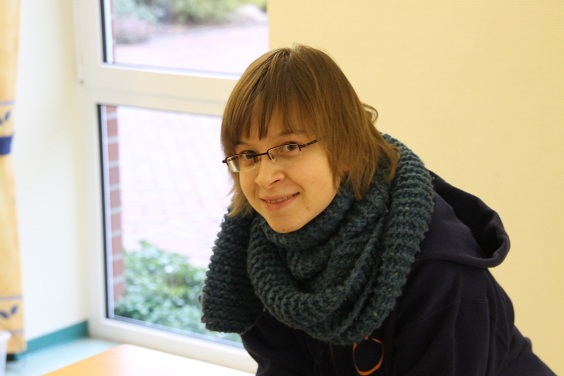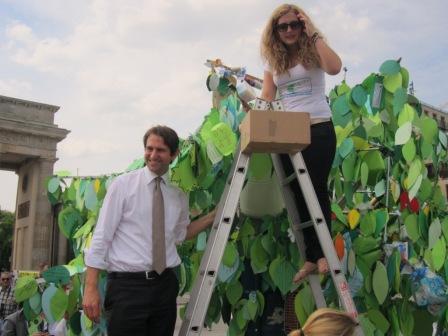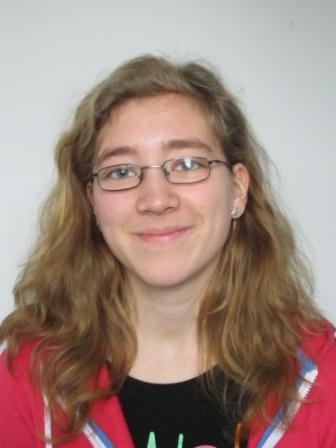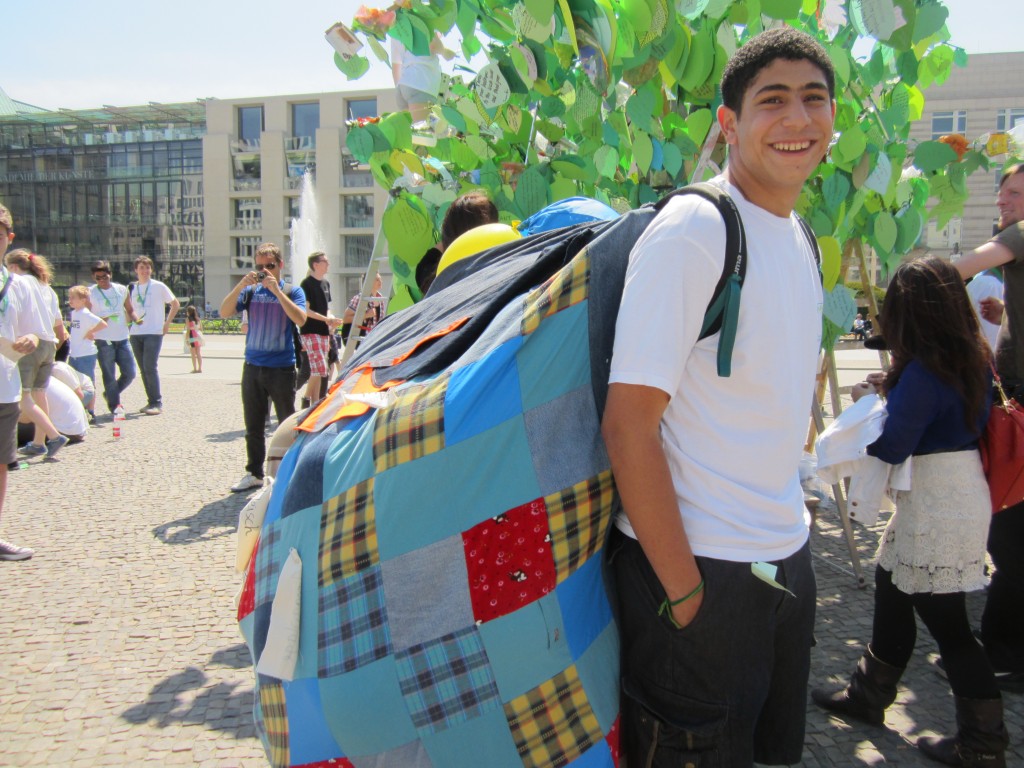Search Results for Tag: Youthinkgreen
Do you really need all of that?
All we need is less?! from youthinkgreen on Vimeo.
Flo is more than a funny guy in a video. He’s a musician with a message: Think about your daily routines, your daily needs, your energy consumption or the way you use cars and plastic bags. Together with the youth network “YOUTHinkgreen” he wants to proof that little changes have an impact in our lives. In an experiment Flo is going to leave his personal comfort zone for a few weeks. From November 25th he will live without unnecessary packaging for 7 days, he will avoid motorized transport for another week and finally he will try to live without electricity. Flo will keep us updated on his feelings, successes and dissappointments, by texts, pictures and some video posts. If you want, you are free to join him.
Climate champs – …fight climate change now, not in 10 years!
 Do you feel responsible for our future? Are you tired of waiting for a breakthrough at climate conferences? If you are already taking action yourself, you are our ClimateChamp and we want to get to know you! Answer our questionnaire to become a part of our new blog series, take your chance to be nominated as a Climate Champ.
Do you feel responsible for our future? Are you tired of waiting for a breakthrough at climate conferences? If you are already taking action yourself, you are our ClimateChamp and we want to get to know you! Answer our questionnaire to become a part of our new blog series, take your chance to be nominated as a Climate Champ.
What is your name? How old are you? And where do you live?
My name is Anke Britta Schmidt. I am 18 years old and I live in Melle, which is a small city near to Osnabrück in Germany.
How does the climate change affect your everyday life in your community?
In Germany the climate change does not affect the everyday live very much. Maybe in the future prices for food will increase or the temperature will rise a bit. But it is not as dangerous as for people who live in Africa or Asia.
What trigger event led you to start fighting climate change?
For me starting to fight the climate change was a lucky coincidence. I found a note at the notice board in my school. A teacher was searching for pupils for his new study group. He wanted to train them to become climate ambassadors. I went to the first meeting and it sounded very interesting to me. So I enrolled for this course.
How exactly do you fight climate change?
I take part in the international youth project youthinkgreen (www.youthinkgreen.org). In this project we learn very much about climate change and things one can do against it. Every group has to work on a sustainable project. Our group from Osnabrück works with children at the age of 8 to 10 years. We talk with them about climate change and general things like rubbish. At the moment we teach them the topic energy. We meet the children once per week. During our last meeting we were able to have a look at an electric car. The children were allowed to take a short ride in the cars. They had a lot of fun. Our idea is showing children very early that our environment is very important to us and that we have to safe it. Some other members of our Osnabrücker group produce their own radio broadcast show once a month. In their program they talk about environmentally topics and present things that are good for the nature – like a solar tree to charge mobile phones. They also talk about other projects from youthinkgreen or criticize bad developments in politics or in the society. There is also another part of our Osnabrücker group that had created a shopping guide. They had a look at different shops and restaurants in Osnabrück and wrote texts about these shops where you are can to buy products that are produced eco friendly. This shopping guide will be published soon.
What do you say to climate change deniers?
We are not the only human living on the earth. We will have children and they will have children, too. When we destroy the earth today we steal our future and the future of our children. Today we use a lot of chemistry, for fracking for example. If you visit the places where fracking takes place, you can easily notice bad effects like sick people or burning water. These are the terrible consequences of pumping chemicals deep into the earth to get natural gas and oil. When you look at rivers for example you can easily measure changes. You only have to compare the ordinary water level from now with the water level from twenty or more years ago. Maybe we are able to convince climate change deniers to start helping the environment. By doing this, they may start believing in the climate change.
Worst case scenario: What do you think your city looks like 10 years from now, if no action had been taken to fight climate change?
There won’t be that many changes in Germany. In other parts of the world there will be much more problems: the sea level will rise, as well as the temperature. No human life will be possible in some parts. Maybe some refugees will come to Europe because they live in these parts of the world. This would lead to more social problems.
Best case scenario: What do you think your city looks like 10 years from now, if more and more action had been taken to fight climate change?
In Osnabrück there are plans that in 10 or 15 years there will only be electric or hybrid busses. There is also a campaign called “mobility 2030”. The aim of this campaign is that the people of Osnabrück change their city. They can make suggestions how these changes should look like. They can take photos, paint pictures, write letters or stories and film their ideas. All these ideas will be published on the campaign homepage.
Short and simple: What do you demand from your government as far as climate change is concerned?
I demand from my government that they convince countries like the United States, India and China to start to fight the climate change now, not in 10 years. If we want to save the world, there has to be taken action today not in some day in the future!
How can interested people take part in your project?
Interested people can search for a youthinkgreen group nearby or they can start their own group. If they don´t have enough time, they can participate in single activities of the groups.
The tricky job of hammering out a climate wishlist
 The first World Youth Sustainability concluded in Berlin recently. It brought together over 150 young people from 31 countries who met policymakers and experts to talk about how their dream of a more sustainable, equitable world could be realized. Two young participants, Anne-Sophie Risse and Teresa Thalmaier, describe their experiences at the tightly-packed summit.
The first World Youth Sustainability concluded in Berlin recently. It brought together over 150 young people from 31 countries who met policymakers and experts to talk about how their dream of a more sustainable, equitable world could be realized. Two young participants, Anne-Sophie Risse and Teresa Thalmaier, describe their experiences at the tightly-packed summit.
Anne-Sophie Risse, youthinkgreen-Team Osnabrück:
Friday, May 17 – Day seven of our first World Youth Sustainability Summit. Off to an early start – my alarm rings at 6 a.m. It’s not so unusual really since I get up at that hour anyway during a normal school week. But yesterday was a long day. We spent the whole day at the Pariser Platz in central Berlin for our Tree of Hope project. It’s made of trash and has pages bearing the wishes, demands, hopes and requests from us and from other people addressed to lawmakers, governments and people around the world.
Now, early Friday morning, it’s our job to hand over the Tree of Hope to German Environment Minister Peter Altmaier. We – that is 160 young people from 31 countries – arrive at the ministry at 8 a.m. We’d come together in Berlin to draft a document expressing what we want to policymakers, business and society. Our meeting with Altmaier lasts just 15 minutes.
 In order to get a solid understanding of some of the issues that made it into the document, we’ve been listening to daily talks by various experts on climate change and other topics. Today, it’s the turn of renowned climate researcher Hans Joachim Schellnhuber. We head to the Potsdam Institute for Climate Impact Research to hear him speak. He’s very competent and understanding and begins his talk by saying “I’ll wake you up when something important comes up!” In addition to several interesting facts on climate change, I take away this impression from the talk – if there’s an acute, common problem then even nations that are sworn enemies can manage to work together.
In order to get a solid understanding of some of the issues that made it into the document, we’ve been listening to daily talks by various experts on climate change and other topics. Today, it’s the turn of renowned climate researcher Hans Joachim Schellnhuber. We head to the Potsdam Institute for Climate Impact Research to hear him speak. He’s very competent and understanding and begins his talk by saying “I’ll wake you up when something important comes up!” In addition to several interesting facts on climate change, I take away this impression from the talk – if there’s an acute, common problem then even nations that are sworn enemies can manage to work together.
I wonder if things have to go that far. With that thought, we head to the next workshop “Climate change – an intergenerational problem.” Carl-Friedrich Schleußner is the expert in this case and says that people need to live in such a way so that life for successive generations is at least just as good. It’s a topic you can discuss forever. So that the day doesn’t end on too theoretical a note, we’re shown videos by the “ClimateMediaFactory.org” – the world as a user of a network dubbed “Earthbook.” The videos were really well done.
Teresa Thalmaier, youthinkgreen-Team Windhoek:
After absorbing so many new impressions, faces, fascinating lectures and different cultures, we headed to the Konrad Adenauer Foundation.
“If you thought the last few days were grueling, then you’d better get prepared for something really tough today. But that’s what you’ll take home with you, something you can be proud of.” That’s how Helmut Spiering, the project founder of youthinkgreen, welcomed us.
Another two long hours to go before lunch. Initially, we sat in groups of maximum ten young people and racked our brains – what do we actually want? What needs to change? How can we shape our world in a more sustainable manner? How can you achieve that aim?
It sounds easier than it is. How do you formulate things that are politically correct and still compelling? But we weren’t the only ones struggling with the problem. After another discussion in a smaller circle, further groups were created. Now four larger with 40 members each worked on their wish lists. Exhausted, we dragged ourselves off to lunch to recharge our batteries. We all really needed it!
But the tough part was still to come. We were asked to discuss the four wish lists from all the groups and to combine then. We – 160 young people from 31 countries – sat excitedly in a large conference room. There were so many different cultures and languages represented. But all that wasn’t meant to hinder us.
The most difficult part often was formulating the document. Often, our statements weren’t concrete enough, at times superfluous – though there were really good ideas behind them. We gained a deep insight into how a parliament works, how politics is done on an international stage. At the end, we had our final document. It’s unbelievable what we achieved in the last weeks and I’m happy to be a part of the youthinkgreen family!
A Song, a Dance and Spots on the Fight Against Climate Change
 Yesterday, the colossal efforts each and every one of us put in the project came to fruition as the pinnacle of our project, the 1st world youth sustainability summit, came to be.
Yesterday, the colossal efforts each and every one of us put in the project came to fruition as the pinnacle of our project, the 1st world youth sustainability summit, came to be.
The event, many of whose attendees were project managers and leading figures in their respective fields, were pleasantly surprised as the youthinkgreen teams that took part in the gala showed discipline, determination and that they were not to be discouraged by the sheer size and importance of the event at hand.
The program, whose highlights were the youthinkgreen rendition of the song ,,Mut zum Handeln” (courage to act), the various student-produced environmentally oriented spots, and the Indian dance showed the unique inter-cultural connection between the various members of the Youthinkgreen.
The excitement at the event rubbed off on each and every one of our guests, with many of them on the verge of euphoria. We were standing hand-in-hand with people whose success has come to be known on every continent of the planet and watched in amazement as they relaxed and spoke to us as peers, not as minors, as friends not as climate change fighters.
All in all, to simply call our summit a success would be an understatement. The Allianz Forum will forever in our hearts be remembered as the place where we graduated into adults, supported along our journey by the constant recognition we received throughout the process.
Written by Mourad Farahat, youthinkgreen Kairo
Handing over the „Tree of Hope“
 The „Tree of Hope“ had a long and fruitful journey. First we planet it at the climate summit in Doha in December 2012. And now it grew at the 1st World Youth Sustainability Summit 2013 in Berlin. The tree is actually not a real tree. It’s trunk is made from garbage and the crown from green paper leafs filled with the wishes, demands and ideas of people from all over the world.
The „Tree of Hope“ had a long and fruitful journey. First we planet it at the climate summit in Doha in December 2012. And now it grew at the 1st World Youth Sustainability Summit 2013 in Berlin. The tree is actually not a real tree. It’s trunk is made from garbage and the crown from green paper leafs filled with the wishes, demands and ideas of people from all over the world.
It’s a beautiful and complex tree, meant to be a demand against mankinds extravagantly and unecological lifestyle. People should see the tree, read the leafs and think about their own daily routines. All 160 participants of the Youth Sustainability Summit collected the wishes and demands from friends and siblings in the 31 countries they call home. The tree grew upto 4 meters yesterday at the Brandenburg Gate in the centre of Berlin. And it grew more leafs as citizens and tourists also started to write on leafs.
 Besides the „Tree of Hope“ we used a 10qm blanket to illustrate the ecological foot- and hand-print everybody has. The foot-print depends on the way people live and how they consume things. The hand-print shows that it’s possible to fight against climate change. So we asked people to leave a colourfull print of feed and hands on the white blanket. The action was a success, it ended with a gala at the Allianzforum (Read the post by Mourad Farahat) where a nice breeze shook the leafs of the trees.
Besides the „Tree of Hope“ we used a 10qm blanket to illustrate the ecological foot- and hand-print everybody has. The foot-print depends on the way people live and how they consume things. The hand-print shows that it’s possible to fight against climate change. So we asked people to leave a colourfull print of feed and hands on the white blanket. The action was a success, it ended with a gala at the Allianzforum (Read the post by Mourad Farahat) where a nice breeze shook the leafs of the trees.
The leafs are filled with all kinds of demands, as you can see on the pictures. The ideas and wishes very much depend on where the writer comes from. You can imagine that a person from a developing countries shares quite different hopes as someone from a industrialized country.
We hope that all our wishes and demands will come true. That’s more than important to leave our children and grandchildren a world that is worth living. The way we live today destroys the future. I personally want to live in a world where nature has a more important role again and not only profit. I wish for more green spaces in cities, more room for bicycles and children to play. The „Tree of Hope“ is now in the hands of the German Environmental Minister Peter Altmaier. We hope for results.
Written by Anke Britta Schmidt, youthinkgreen Osnabrück /ke








Feedback